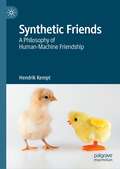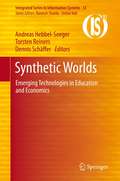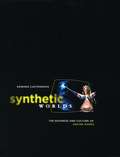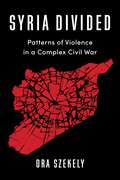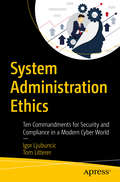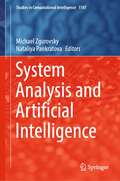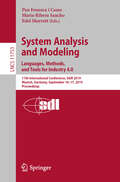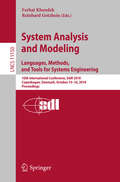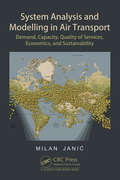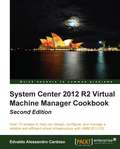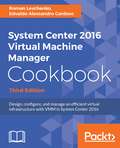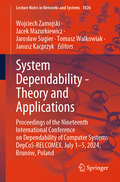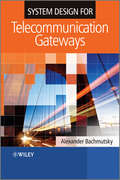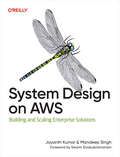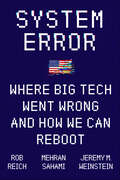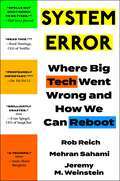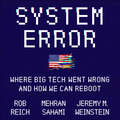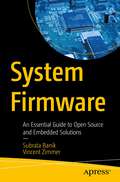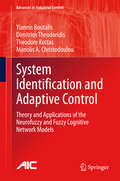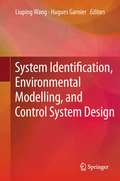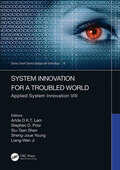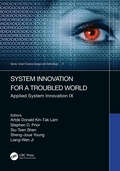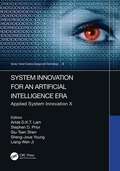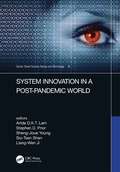- Table View
- List View
Synthetic Friends: A Philosophy of Human-Machine Friendship
by Hendrik KemptThis book explores the notion of whether we can be friends with machines in a philosophically meaningful way. Depending on our concept of friendship, we may be inclined to answer differently. Since social technology has made new forms of friendships possible between people across the globe, the author argues that the philosophical concept of friendship, forged thousands of years ago, should be re-examined. The author proposes a new approach to the debate that reflects the unique relationship we can build with machines as our synthetic friends.
Synthetic Worlds: Emerging Technologies in Education and Economics
by Torsten Reiners Andreas Hebbel-Seeger Dennis SchäfferSynthetic Worlds, Virtual Worlds, and Alternate Realities are all terms used to describe the phenomenon of computer-based, simulated environments in which users inhabit and interact via avatars. The best-known commercial applications are in the form of electronic gaming, and particularly in massively-multiplayer online role-playing games like World of Warcraft or Second Life. Less known, but possibly more important, is the rapid adoption of platforms in education and business, where Serious Games are being used for training purposes, and even Second Life is being used in many situations that formerly required travel. Linden Lab, creator of Second Life, recently announced the creation of Second Life Enterprise, with customers including IBM, Northrop Grumman, and the US Naval Undersea Warfare Center. The editors of this book captures the state of research in the field intended to reflect the rapidly growing yet relatively young market in education and business. The general focus is set on the scientific community but integrates the practical applications for businesses, with papers on information systems, business models, and economics. In six parts, international authors - all experts in their field - discuss the current state-of-the-art of virtual worlds/alternate realities and how the field will develop over the next years. Chapters discuss the influences and impacts in and around virtual worlds. Part four is about education, with a focus on learning environments and experiences, pedagogical models, and the effects on the different roles in the educational sector. The book looks at business models and how companies can participate in virtual worlds while receiving a return on investment, and includes cases and scenarios of integration, from design, implementation to application.
Synthetic Worlds: The Business and Culture of Online Games
by Edward CastronovaCastronova offers the first comprehensive look at the online game industry, exploring its implications for business and culture alike. He starts with the players, giving us a revealing look into the everyday lives of the gamers--outlining what they do in their synthetic worlds and why.
Syria Divided: Patterns of Violence in a Complex Civil War (Columbia Studies in Middle East Politics)
by Ora SzekelyThe civil war in Syria—which has claimed more than 600,000 lives and displaced over half of the country’s population since 2011—is an enormously complex conflict. The combatants include a wide array of state and nonstate forces, both Syrian and international. Adding to the war’s complexity, its many participants understand and explain the war in a range of different ways. For some, it is a fight for dignity and democracy; for others, a sectarian or communal conflict; still others see it as a fight against terrorism or a consequence of foreign interference.Ora Szekely draws on sources including in-depth interviews, conflict data, and propaganda distributed through social media to examine how these competing narratives have shaped the course of the conflict. Mapping out the broad patterns of violence among combatants and against civilians, Szekely argues that the competition to control the narrative in the eyes of important audiences at home and abroad has not only influenced the choices of participants, it has also—shaped in part by the use of social media—led many to treat warfare as a kind of performance.An insightful analysis of the forces fueling a brutal civil war, Syria Divided offers new perspectives on the performative aspects of violence, the weaponization of social media, and key features of twenty-first-century warfare.
System Administration Ethics: Ten Commandments for Security and Compliance in a Modern Cyber World
by Igor Ljubuncic Tom LittererSuccessfully navigate through the ever-changing world of technology and ethics and reconcile system administration principles for separation of duty, account segmentation, administrative groups and data protection. As security breaches become more common, businesses need to protect themselves when facing ethical dilemmas in today’s digital landscape. This book serves as a equitable guideline in helping system administrators, engineers – as well as their managers – on coping with the ethical challenges of technology and security in the modern data center by providing real-life stories, scenarios, and use cases from companies both large and small. You'll examine the problems and challenges that people working with customer data, security and system administration may face in the cyber world and review the boundaries and tools for remaining ethical in an environment where it is so easy to step over a line - intentionally or accidentally. You'll also see how to correctly deal with multiple ethical situations, problems that arise, and their potential consequences, with examples from both classic and DevOps-based environments.Using the appropriate rules of engagement, best policies and practices, and proactive “building/strengthening” behaviors, System Administration Ethics provides the necessary tools to securely run an ethically correct environment. What You'll LearnThe concepts of Least Privilege and Need to KnowRequest change approval and conduct change communicationFollow "Break Glass" emergency proceduresCode with data breaches, hacking and security violations, and proactively embrace and design for failures Build and gain trust with employees and build the right ethical cultureReview what managers can do to improve ethics and protect their employeesWho This Book Is ForThis book’s primary audience includes system administrators and information security specialists engaged with the creation, process and administration of security policies and systems. A secondary audience includes company leaders seeking to improve the security, privacy, and behavioral practices.
System Analysis and Artificial Intelligence (Studies in Computational Intelligence #1107)
by Michael Zgurovsky Nataliya PankratovaThis book contains the latest scientific work of Ukrainian scientists and their colleagues from other countries of the world in three interrelated areas: systems analysis, artificial intelligence and data mining. The included articles present the theoretical foundations and practical applications of the latest tools and methods of artificial intelligence, scenario planning, decision making and computational intelligence for important areas of human activity. The tools and methods presented in the book are continuously evolving and finding new applications across various fields, contributing to advancements and efficiencies in different industries: healthcare, finance, retail and E-commerce, manufacturing and industrial automation, transportation and logistics advancements and cybersecurity. The results of the book are useful to teachers, scientists, graduate students of universities and managers of large companies specializing in strategic planning, engineering design of complex systems, decision-making, optimization of operations and other related fields of knowledge and practice.
System Analysis and Modeling. Languages, Methods, and Tools for Industry 4.0: 11th International Conference, SAM 2019, Munich, Germany, September 16–17, 2019, Proceedings (Lecture Notes in Computer Science #11753)
by Pau Fonseca i Casas Maria-Ribera Sancho Edel SherrattThis book constitutes the refereed proceedings of the 11th International Conference on System Analysis and Modeling, SAM 2019, held in Munich, Germany, in September 2019.The 12 full papers and 2 work in progress papers presented together with one keynote talk were carefully reviewed and selected from 28 submissions. The papers discuss the most recent innovations, trends, and experiences in modeling and analysis of complex systems using ITU-T's Specification and Description Language (SDL-2010) and Message Sequence Chart (MSC) notations, as well as related system design languages — including UML, ASN.1, TTCN, SysML, and the User Requirements Notation (URN). SAM 2019’s theme was “Languages, Methods, and Tools for Industry 4.0.”
System Analysis and Modeling. Languages, Methods, and Tools for Systems Engineering: 10th International Conference, SAM 2018, Copenhagen, Denmark, October 15–16, 2018, Proceedings (Lecture Notes in Computer Science #11150)
by Ferhat Khendek Reinhard GotzheinThis book constitutes the refereed proceedings of the 10th International Conference on System Analysis and Modeling, SAM 2018, held in Copenhagen Denmark, in October 2018. The 12 full papers and 2 short papers presented were carefully reviewed and selected from 24 submissions. The papers describe innovations, trends, and experiences in modeling and analysis of complex systems using ITU-T's Specification and Description Language (SDL-2010) and Message Sequence Chart (MSC) notations, as well as related system design languages — including UML, ASN.1, TTCN, SysML and the User Requirements Notation (URN). This year’s edition of SAM will be under the theme “Languages, Methods, and Tools for Systems Engineering”, including languages and methods standardized by the ITU-T, and domain-specific languages. Also included are software engineering technologies, such as for requirements engineering, software verification and validation, and automated code generation.
System Analysis and Modelling in Air Transport: Demand, Capacity, Quality of Services, Economic, and Sustainability
by Milan JanićThis book presents a comprehensive analysis and modelling of demand, capacity, quality of services, economics, and sustainability of the air transport system and its main components - - airports, airlines, and ATC/ATM (Air Traffic Control/Management). Airports consist of the airside and landside area characterized by their capacities for handling demand such as aircraft, air passengers, and air freight/cargo shipments. Regarding spatial configuration, airlines generally operate hub-and-spoke (conventional or legacy airlines) and point-to-point (LCCs - Low Cost Carriers) air route networks. Their fleets consisting of different aircraft types provide transport capacity for serving demand including air passengers and freight/cargo shipments. The ATC/ATM includes the controlled airspace, traffic management and control facilities and equipment on the ground, space, and on board aircraft, and the ATC Controllers). They all provide capacity to handle demand consisting of the flights between origin and destination airports carried out by airline aircraft. The outcome from the interrelationships between demand and capacity at these components materializes as the quality of services. At airports and airlines this is generally expressed by congestion and delays of aircraft, air passengers, and freight/cargo shipments. At ATC/ATM, this is expressed by delays, horizontal and vertical in-efficiency, and safety of flights. Economics of each component relate to its revenues, costs, and profits from handling demand, i.e., providing services of given quality. The sustainability of air transport system has become increasingly important issue for many internal and external actors/stakeholders involved to deal with. This has implied increasing the system’s overall social-economic effects/benefits while reducing or maintaining constant impacts/costs on the environment and society at both global and regional/local scale under conditions of continuous medium- to long term growth.
System Center 2012 R2 Virtual Machine Manager Cookbook
by Edvaldo Alessandro CardosoThis book is a step-by-step guide packed with recipes that cover architecture design and planning. The book is also full of deployment tips, techniques, and solutions. If you are a solutions architect, technical consultant, administrator, or any other virtualization enthusiast who needs to use Microsoft System Center Virtual Machine Manager in a real-world environment, then this is the book for you. We assume that you have previous experience with Windows 2012 R2 and Hyper-V.
System Center 2016 Virtual Machine Manager Cookbook, Third Edition: Design, Configure, And Manage An Efficient Virtual Infrastructure With Vmm In System Center 2016
by Roman LevchenkoMicrosoft System Center Virtual Machine Manager (SCVMM) focuses on efficiency with multiple features to help administrators consolidate physical servers within a centrally virtualized environment. This book will allow you to implement the Microsoft System Center family of components effectively and efficiently.
System Center 2016 Virtual Machine Manager Cookbook,: Design, configure, and manage an efficient virtual infrastructure with VMM in System Center 2016
by Edvaldo Alessandro Cardoso Roman LevchenkoMaximize your administration skills effectively and efficiently Key Features Implement cost-effective virtualization solutions for your organization with actionable recipes Explore the concepts of VMM with real-world use cases Use the latest features with VMM 2016 such as Cluster OS Rolling Upgrade, Guarded Fabric and Storage Spaces Direct Book Description Virtual Machine Manager (VMM) 2016 is part of the System Center suite to configure and manage datacenters and offers a unified management experience on-premises and Azure cloud. This book will be your best companion for day-to-day virtualization needs within your organization, as it takes you through a series of recipes to simplify and plan a highly scalable and available virtual infrastructure. You will learn the deployment tips, techniques, and solutions designed to show users how to improve VMM 2016 in a real-world scenario. The chapters are divided in a way that will allow you to implement the VMM 2016 and additional solutions required to effectively manage and monitor your fabrics and clouds. We will cover the most important new features in VMM 2016 across networking, storage, and compute, including brand new Guarded Fabric, Shielded VMs and Storage Spaces Direct. The recipes in the book provide step-by-step instructions giving you the simplest way to dive into VMM fabric concepts, private cloud, and integration with external solutions such as VMware, Operations Manager, and the Windows Azure Pack. By the end of this book, you will be armed with the knowledge you require to start designing and implementing virtual infrastructures in VMM 2016. What you will learn - Plan and design a VMM architecture for real-world deployment - Configure fabric resources, including compute, networking, and storage - Create and manage Storage Spaces Direct clusters in VMM - Configure Guarded Fabric with Shielded VMs - Create and deploy virtual machine templates and multi-tier services - Manage Hyper-V and VMware environments from VMM - Enhance monitoring and management capabilities - Upgrade to VMM 2016 from previous versions Who this book is for If you are a solutions architect, technical consultant, administrator, or any other virtualization enthusiast who needs to use Microsoft System Center Virtual Machine Manager in a real-world environment, then this is the book for you.
System Dependability - Theory and Applications: Proceedings of the Nineteenth International Conference on Dependability of Computer Systems DepCoS-RELCOMEX. July 1–5, 2024, Brunów, Poland (Lecture Notes in Networks and Systems #1026)
by Janusz Kacprzyk Wojciech Zamojski Jacek Mazurkiewicz Jarosław Sugier Tomasz WalkowiakThis book presents a selection of papers about problems which arise in dependability studies of contemporary computer systems and networks. Their collection should be an interesting and inspiring source material for scientists, researchers, engineers, and students who must consider diverse dependability characteristics in design, analysis, or maintenance of computer systems and networks. The papers were presented during the 19th DepCoS-RELCOMEX conference which was the next event in a series organized annually since 2006. Originating as a scientific platform for discussions of reliability aspects in computer engineering, the topical scope of the conference has been constantly expanded to incorporate new dependability challenges brought by recent advances in systems and information technologies. Currently, dependable operation in the context of computer processing means obtaining reliable (true and timely) results in the conditions of processing both quantitative and qualitative data, using precise or fuzzy (often: imitating) models and algorithms. With increasing use of artificial intelligence algorithms and tools, dependability in contemporary information technology and computer engineering calls for methods based on cognitive systems and deep learning techniques. Topical variety of the papers included in these proceedings proves that almost all applications of modern computer systems and networks must take into account the aspect of dependability and also illustrates a wide diversity of multidisciplinary subjects which needs to be considered in this context.
System Design for Telecommunication Gateways
by Alexander BachmutskySystem Design for Telecommunication Gateways provides a thorough review of designing telecommunication network equipment based on the latest hardware designs and software methods available on the market. Focusing on high-end efficient designs that challenge all aspects of the system architecture, this book helps readers to understand a broader view of the system design, analyze all its most critical components, and select the parts that best fit a particular application. In many cases new technology trends, potential future developments, system flexibility and capability extensions are outlined in preparation for the longevity typical for products in the industry.Key features:Combines software and hardware aspects of the system design. Defines components and services supported by open-source and commercial basic and extended software platforms, including operating systems, middleware, security, routing, management layer and more. Focuses on disruptive technologies. Provides guidelines for developing software architectures based on multi-threaded, multi-process, multi-instance, multi-core, multi-chip, multi-blade and multi-chassis designs. Covers a number of advanced high-speed interconnect and fabric interface technologies and their commercial implementations. Presents different system form factors from compact pizza-box styles to medium and large bladed systems, including IBM BladeCenter, ATCA and microTCA-based chassis. Describes different mezzanine cards, such as PMC, PrPMC, XMC, AMC and others.
System Design on AWS
by Mandeep Singh Jayanth KumarEnterprises building complex and large-scale applications in the cloud face multiple challenges. From figuring out the right tools to estimating the right provisioning, nearly every solution comes with a complicated set of choices and trade-offs. AWS provides a one-stop shop for building and scaling these applications, and this practical guide helps you decide which pieces to use and how to fit them together.Authors Jayanth Kumar and Mandeep Singh equip software architects and engineers with essential AWS and system design knowledge to help you make good decisions and overcome the challenges of designing and scaling enterprise software architecture. By diving into specific use cases, you'll understand how these principles and resources can be applied to real-world problems.With this book, you will:Learn the basics and best practices of successful system designUnderstand key AWS services and their strengths and limitations for building large-scale systemsExamine engineering patterns and principles that best support large-scale systems, and learn how to design architecture with scalability, operations, and resilience in mindLearn what highly performant and cost-optimized architectures look like on AWS and the tools and frameworks that are best for specific use cases
System Error: Where Big Tech Went Wrong and How We Can Reboot
by Rob Reich Jeremy M. Weinstein Mehran Sahami"System Error is a triumph: an analysis of the critical challenges facing our digital society that is as accessible as it is sophisticated." — Anne-Marie Slaughter, CEO of New AmericaA forward-thinking manifesto from three Stanford professors—experts who have worked at ground zero of the tech revolution for decades—which reveals how big tech’s obsession with optimization and efficiency has sacrificed fundamental human values and outlines steps we can take to change course, renew our democracy, and save ourselves.In no more than the blink of an eye, a naïve optimism about technology’s liberating potential has given way to a dystopian obsession with biased algorithms, surveillance capitalism, and job-displacing robots. Yet too few of us see any alternative to accepting the onward march of technology. We have simply accepted a technological future designed for us by technologists, the venture capitalists who fund them, and the politicians who give them free rein.It doesn’t need to be this way.System Error exposes the root of our current predicament: how big tech’s relentless focus on optimization is driving a future that reinforces discrimination, erodes privacy, displaces workers, and pollutes the information we get. This optimization mindset substitutes what companies care about for the values that we as a democratic society might choose to prioritize. Well-intentioned optimizers fail to measure all that is meaningful and, when their creative disruptions achieve great scale, they impose their values upon the rest of us.Armed with an understanding of how technologists think and exercise their power, three Stanford professors—a philosopher working at the intersection of tech and ethics, a political scientist who served under Obama, and the director of the undergraduate Computer Science program at Stanford (also an early Google engineer)—reveal how we can hold that power to account.Troubled by the values that permeate the university’s student body and its culture, they worked together to chart a new path forward, creating a popular course to transform how tomorrow’s technologists approach their profession. Now, as the dominance of big tech becomes an explosive societal conundrum, they share their provocative insights and concrete solutions to help everyone understand what is happening, what is at stake, and what we can do to control technology instead of letting it control us.
System Error: Where Big Tech Went Wrong and How We Can Reboot
by Rob Reich Jeremy Weinstein Mehran SahamiRead this if you want to understand how to shape our technological future and reinvigorate democracy along the way. -- Reed Hastings, co-founder and CEO of Netflix__________A forward-thinking manifesto from three Stanford professors which reveals how big tech's obsession with optimization and efficiency has sacrificed fundamental human values and outlines steps we can take to change course, renew our democracy, and save ourselves.__________In no more than the blink of an eye, a naïve optimism about technology's liberating potential has given way to a dystopian obsession with biased algorithms, surveillance capitalism, and job-displacing robots. Yet too few of us see any alternative to accepting the onward march of technology. We have simply accepted a technological future designed for us by technologists, the venture capitalists who fund them, and the politicians who give them free rein.It doesn't need to be this way.System Error exposes the root of our current predicament: how big tech's relentless focus on optimization is driving a future that reinforces discrimination, erodes privacy, displaces workers, and pollutes the information we get.Armed with an understanding of how technologists think and exercise their power, three Stanford professors - a philosopher working at the intersection of tech and ethics, a political scientist who served under Obama, and the director of the undergraduate Computer Science program at Stanford (also an early Google engineer) - reveal how we can hold that power to account. As the dominance of big tech becomes an explosive societal conundrum, they share their provocative insights and concrete solutions to help everyone understand what is happening, what is at stake, and what we can do to control technology instead of letting it control us.
System Error: Where Big Tech Went Wrong and How We Can Reboot
by Rob Reich Jeremy Weinstein Mehran SahamiRead this if you want to understand how to shape our technological future and reinvigorate democracy along the way. -- Reed Hastings, co-founder and CEO of Netflix__________A forward-thinking manifesto from three Stanford professors which reveals how big tech's obsession with optimization and efficiency has sacrificed fundamental human values and outlines steps we can take to change course, renew our democracy, and save ourselves.__________In no more than the blink of an eye, a naïve optimism about technology's liberating potential has given way to a dystopian obsession with biased algorithms, surveillance capitalism, and job-displacing robots. Yet too few of us see any alternative to accepting the onward march of technology. We have simply accepted a technological future designed for us by technologists, the venture capitalists who fund them, and the politicians who give them free rein.It doesn't need to be this way.System Error exposes the root of our current predicament: how big tech's relentless focus on optimization is driving a future that reinforces discrimination, erodes privacy, displaces workers, and pollutes the information we get.Armed with an understanding of how technologists think and exercise their power, three Stanford professors - a philosopher working at the intersection of tech and ethics, a political scientist who served under Obama, and the director of the undergraduate Computer Science program at Stanford (also an early Google engineer) - reveal how we can hold that power to account. As the dominance of big tech becomes an explosive societal conundrum, they share their provocative insights and concrete solutions to help everyone understand what is happening, what is at stake, and what we can do to control technology instead of letting it control us.(P) 2021 HarperCollins Publishers
System Firmware: An Essential Guide to Open Source and Embedded Solutions
by Vincent Zimmer Subrata BanikFind the right bootloader solution or combination of firmware required to boot a platform considering its security, product features, and optimized boot solutions. This book covers system boot firmware, focusing on real-world firmware migration from closed source to open source adaptation. The book provides an architectural overview of popular boot firmware. This includes both closed sourced and/or open source in nature, such as Unified Extensible Firmware Interface (UEFI), coreboot, and Slim Bootloader and their applicable market segments based on product development and deployment requirements. Traditional system firmware is often complex and closed sourced whereas modern firmware is still a kind of hybrid between closed and open source. But what might a future firmware model look like? The most simplistic boot firmware solution uses open source firmware development. This book helps you decide how to choose the right boot firmware for your products and develop your own boot firmware using open source. Coverage includes: Why open source firmware is used over closed sourceThe pros and cons of closed and open source firmwareA hybrid work model: for faster bring-up activity using closed source, binary integrated with open source firmware What You Will LearnUnderstand the architecture of standard and popular boot firmwarePick the correct bootloader for your required target hardwareDesign a hybrid workflow model for the latest chipset platformUnderstand popular payload architectures and offerings for embedded systemsSelect the right payload for your bootloader solution to boot to the operating systemOptimize the system firmware boot time based on your target hardware requirementKnow the product development cycle using open source firmware developmentWho This Book Is For Embedded firmware and software engineers migrating the product development from closed source firmware to open source firmware for product adaptation needs as well as engineers working for open source firmware development. A secondary audience includes engineers working on various bootloaders such as open source firmware, UEFI, and Slim Bootloader development, as well as undergraduate and graduate students working on developing firmware skill sets.
System Identification and Adaptive Control
by Yiannis Boutalis Dimitrios Theodoridis Theodore Kottas Manolis A. ChristodoulouPresenting current trends in the development and applications of intelligent systems in engineering, this monograph focuses on recent research results in system identification and control. The recurrent neurofuzzy and the fuzzy cognitive network (FCN) models are presented Both models are suitable for partially-known or unknown complex time-varying systems. Neurofuzzy Adaptive Control contains rigorous proofs of its statements which result in concrete conclusions for the selection of the design parameters of the algorithms presented. The neurofuzzy model combines concepts from fuzzy systems and recurrent high-order neural networks to produce powerful system approximations that are used for adaptive control. The FCN model stems from fuzzy cognitive maps and uses the notion of "concepts" and their causal relationships to capture the behavior of complex systems. The book shows how, with the benefit of proper training algorithms, these models are potent system emulators suitable for use in engineering systems All chapters are supported by illustrative simulation experiments, while separate chapters are devoted to the potential industrial applications of each model including projects in: * contemporary power generation; * process control and * conventional benchmarking problems. Researchers and graduate students working in adaptive estimation and intelligent control will find Neurofuzzy Adaptive Control of interest both for the currency of its models and because it demonstrates their relevance for real systems. The monograph also shows industrial engineers how to test intelligent adaptive control easily using proven theoretical results.
System Identification, Environmental Modelling, and Control System Design
by Hugues Garnier Liuping WangThis book is dedicated to Prof. Peter Young on his 70th birthday. Professor Young has been a pioneer in systems and control, and over the past 45 years he has influenced many developments in this field. This volume comprises a collection of contributions by leading experts in system identification, time-series analysis, environmetric modelling and control system design - modern research in topics that reflect important areas of interest in Professor Young's research career. Recent theoretical developments in and relevant applications of these areas are explored treating the various subjects broadly and in depth. The authoritative and up-to-date research presented here will be of interest to academic researcher in control and disciplines related to environmental research, particularly those to with water systems. The tutorial style in which many of the contributions are composed also makes the book suitable as a source of study material for graduate students in those areas.
System Innovation for a Troubled World: Applied System Innovation VIII. Proceedings of the IEEE 8th International Conference on Applied System Innovation (ICASI 2022), April 21–23, 2022, Sun Moon Lake, Nantou, Taiwan (Smart Science, Design & Technology)
by Stephen D. Prior Siu-Tsen Shen Sheng-Joue Young Liang-Wen Ji Lam, Artde Donald Kin-TakSystem Innovation for a Troubled World: Applied System Innovation VIII contains roughly one tenth of the total of 250 contributions from 8 different countries that were presented at the IEEE 8th International Conference on Applied System Innovation (ICASI 2022, Sun Moon Lake, Nantou, Taiwan, 21-23 April 2022). This book aims to provide an integrated communication platform for researchers from a wide range of topics including: - Information Technology - Communication Science - Applied Mathematics - Computer Science - Advanced Material Science - Engineering System Innovation for a Troubled World: Applied System Innovation VIII aims at science and engineering technologists, academics and professionals from the above mentioned areas.
System Innovation for a World in Transition: Applied System Innovation IX. Proceedings of the 9th International Conference on Applied System Innovation 2023 (ICASI 2023), Chiba, Japan, 21-25 April 2023 (Smart Science, Design & Technology)
by Stephen D. Prior Siu-Tsen Shen Sheng-Joue Young Liang-Wen Ji Kin-Tak Lam, Artde DonaldSystem Innovation for a World in Transition: Applied System Innovation IX, includes the contributions presented at the IEEE 9th International Conference on Applied System Innovation (ICASI 2023, Chiba, Japan, 21-25 April 2023). The conference received more than 600 submitted papers from 12 different countries, whereby roughly one quarter of these papers was selected to present at ICASI 2023. The book aims to provide an integrated communication platform for researchers from a wide range of topics including information technology, communication science, applied mathematics, computer science, advanced material science, and engineering. Hopefully, it will enhance interdisciplinary collaborations between science and engineering technologists in the fields of academics and related industries.
System Innovation for an Artificial Intelligence Era: Applied System Innovation X
by Stephen D. Prior Siu-Tsen Shen Sheng-Joue Young Liang-Wen Ji Kin-Tak Lam, Artde DonaldSystem Innovation for an Artificial Intelligence Era: Applied System Innovation X contains the papers presented at the IEEE 10th International Conference on Applied System Innovation (ICASI 2024, Kyoto, Japan, 17-21 April 2024. Of the more than 600 submitted papers from 12 different countries, after review approximately a quarter was accepted for publication. The book aims to provide an integrated communication platform for researchers from a wide range of topics including information technology, communication science, applied mathematics, computer science, advanced material science, and engineering. System Innovation for an Artificial Intelligence Era: Applied System Innovation X enhances interdisciplinary collaborations between science and engineering and is aimed at academics and technologists interested in the above mentioned areas.
System Innovation in a Post-Pandemic World: Proceedings of the IEEE 7th International Conference on Applied System Innovation (ICASI 2021), September 24-25, 2021, Alishan, Taiwan (Smart Science, Design & Technology)
by Artde Donald Kin-Tak LamSystem Innovation in a Post-Pandemic World contains the papers presented at the IEEE 7th International Conference on Applied System Innovation (ICASI 2021, Alishan, Taiwan, September 24-25, 2021). The conference received more than 200 submitted papers from 11 different countries, whereby roughly one third of these papers was selected by the committees and invited to present at ICASI 2021. The book provides an integrated communication platform for researchers from a wide range of disciplines including information technology, communication science, applied mathematics, computer science, advanced material science, and engineering. Hopefully, interdisciplinary collaborations between science and engineering technologists in the domains of academia and industry will be enhanced via this unique international network.
